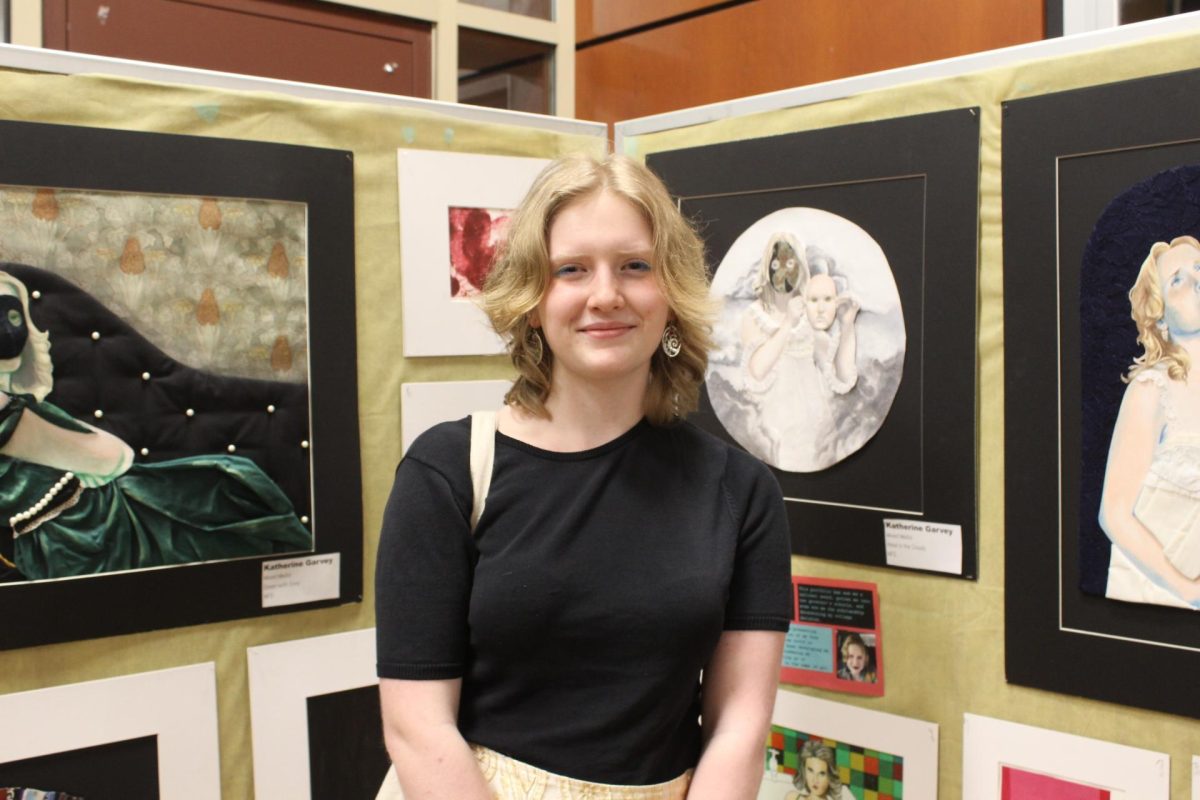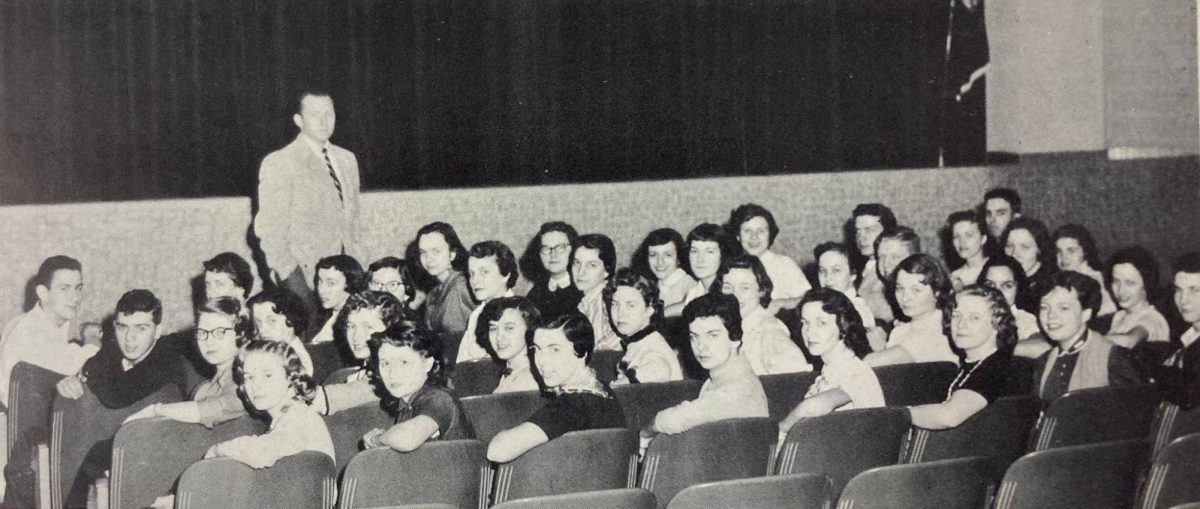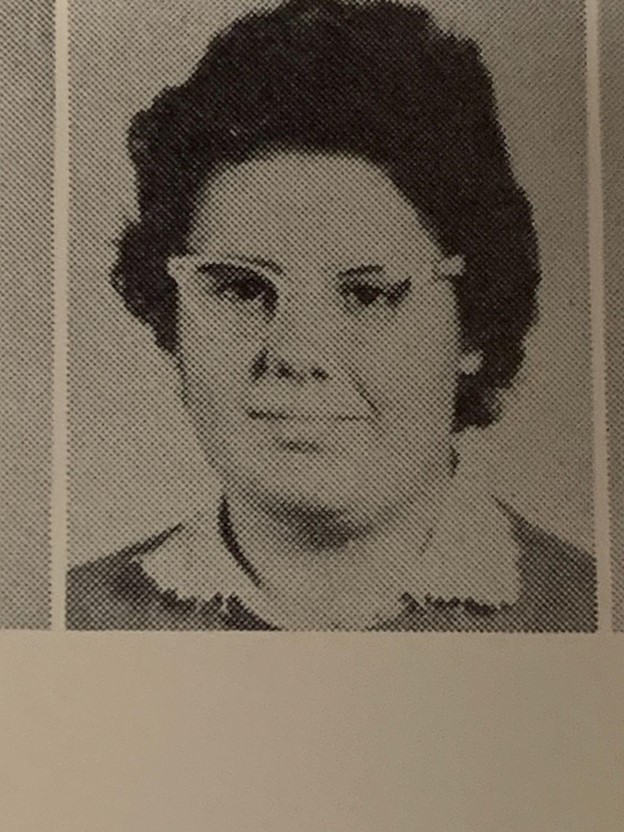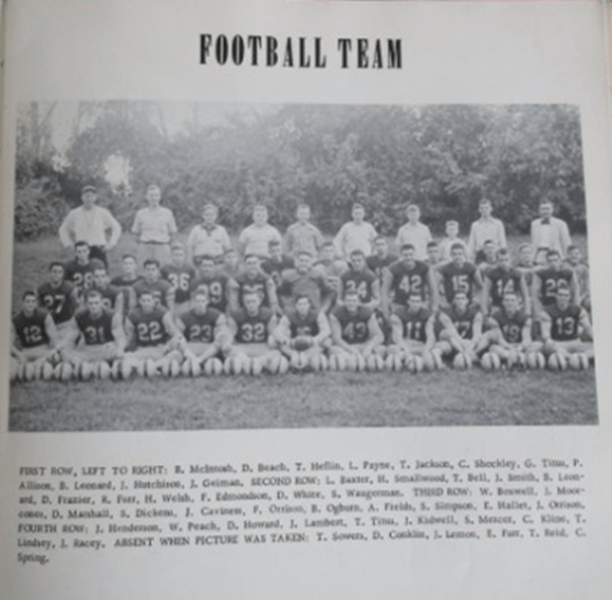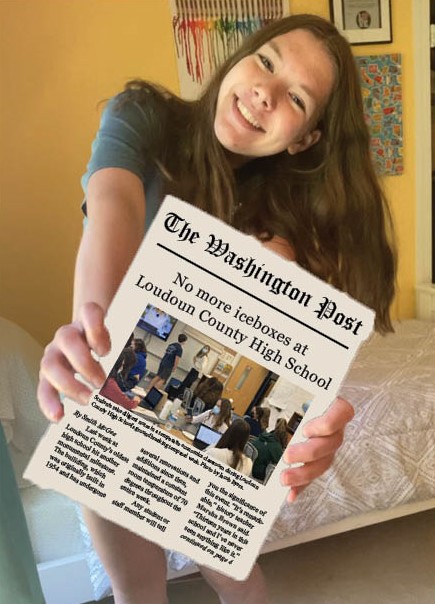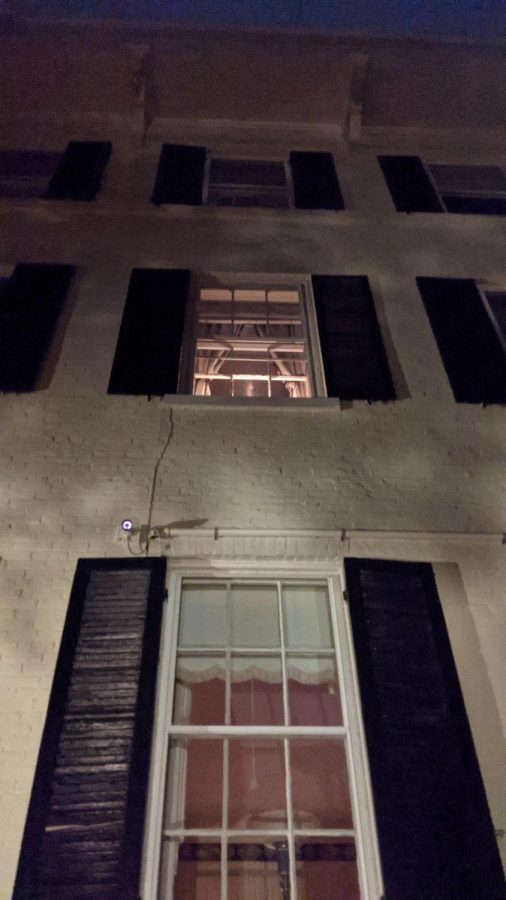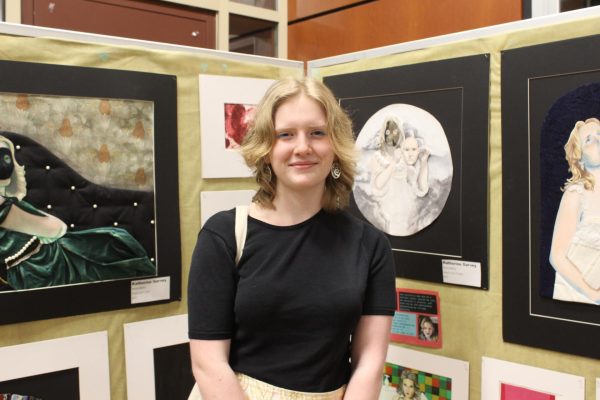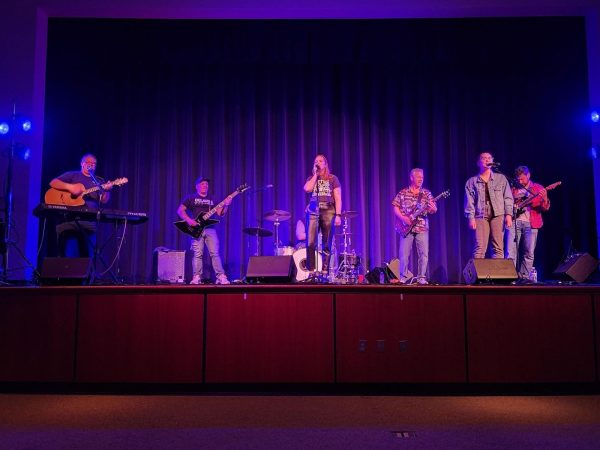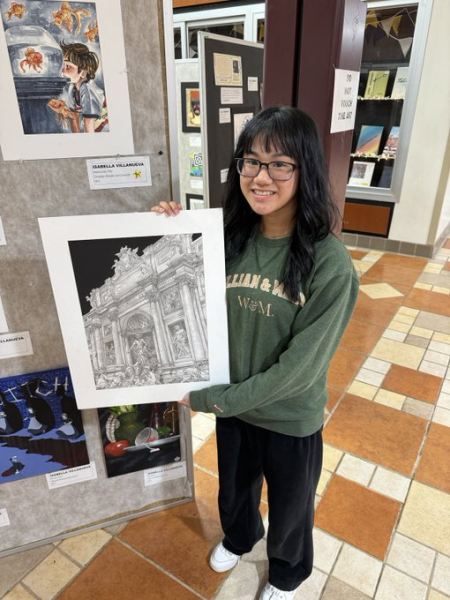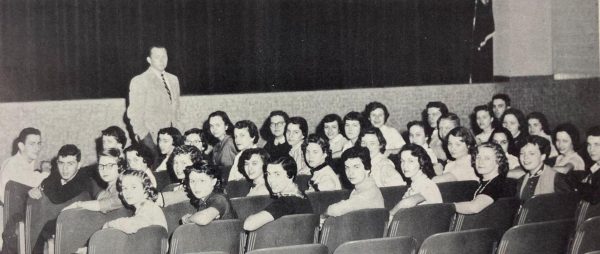Leesburg’s Most Haunted
This is the dress that the ghost of the Loudoun Museum, Elizabeth, described to the psychic. Women of the 17th and 18th century wore this style. Photo credit by Liberty Harrison
Old towns are always rumoured to be haunted, so is it crazy to believe that our quiet town of Leesburg could be plagued by ghosts?
On October 25, Liberty Harrison and I attended the Leesburg Ghost Tours which are hosted annually by the Virginia Scientific Research Association (VSRA). VSRA was founded in 1992 by Joseph Holbert, and the organization is dedicated to uncovering the mysteries of the supernatural.
VSRA narrates a series of stories told through the Ghost Tours that will change the way you view Leesburg all together.
The tour started off at the Loudoun Museum, which is one of the oldest establishments in Leesburg dating back to the late 1700s. Harrison and I arrived at 6 PM along with a crowd of eight other people, and were introduced to our tour guide, Nadily Huelsmen.
Huelsmen has been a tour guide since 2009 and considered herself to be an expert on the ghost tales told throughout the night.
From the Museum, we were taken to the courthouse. Decorated with portraits of muted colors featuring former presidents, benches of dark wood covered in red, velvet cushions, and a distinctly old library smell, it truly was a walk back in time. Two women dressed in 1872 attire of hoopskirt dresses and black shaws spoke of Leesburg’s first serial killer.
The Court House:
Emily Lloyd had a family of five: her husband, Charles Lloyd, two sons, Henry and George, and two daughters, Annie and Maud. However, in the 1870s a string of mysterious events ending in everyone of her immediate family members dropping like flies.
First, Charles Lloyd became ill with pneumonia, until Emily Lloyd gave him a special tea to cure his sickness. He underwent a false recovery July 24, and suddenly passed away.
Later on, the grieving widow was only hit harder when her two sons, Henry and George, died just two days apart on July 24-25, 1870 after eating blackberries they found in the woods.
To help Emily Lloyd, Mrs. Hammerly, her elderly Aunt, traveled to Leesburg, but died just a few weeks later in the summer of 1781.
Still, Emily has her daughters to take comfort in.
Nope.
On February 16th, 1872, Annie Lloyd died from cholera. This was found to be incredibly strange, as it was uncommon for only one member of the family to get sick with that particular disease.
Something else that bordered on suspicion was that Annie Lloyd had symptoms similar to the ones of Charles Lloyd, but the two had different illnesses that weren’t related in the slightest.
Finally, the youngest daughter Maud Lloyd died on March 25, 1872, displaying the same symptoms as Annie and Charles Lloyd.
With the death of five people, the mayor called a Coroner’s jury who began to further investigate the situation.
They interrogated several people of Leesburg, including the shopkeeper and a maid who worked for the Lloyds.
The shopkeeper, unnamed, recorded Emily Lloyd purchasing one ounce of arsenic to get rid of the “rats’” that had invaded her home. The Coroners proceed to question the maid, who heatedly reported that there had never been one rat in her home and there never would be.
The Coroners then talked to Emily Lloyd, who admitted to purchasing arsenic, but lost it on her walk home from the apothecary. Her excuse, however, was not bought as she only lived five minutes away from the apothecary.
Upon receiving this information, Emily Lloyd was arrested and sent to prison for six months before her trial.
During this time, Maud’s body was pulled from its grave and her stomach contents were sent to Boston to be searched for arsenic.
While in court Emily was described as “stoic one moment and hysterical the next”. Her trial lasted six days.
When the report of Maud’s stomach contents came back, the suspicions had been confirmed; high concentrations of arsenic were found.
The jury now had to decide whether Emily was guilty or innocent, but there was bias within them. One of the jurors on the case said he would not hang Emily Lloyd even if she had poisoned the whole town, because she was an old sweetheart of his.
Finally, the jury announced the verdict: not guilty.
Regardless of the evidence against her, Emily Lloyd was a woman, and a woman could never murder her entire family.
She was released from jail and disappeared, never to be seen or heard from again.
It was only after her trial and disappearance that a series of shocking information came out. Charles Lloyd inherited a large sum of money upon his death, which was to be distributed evenly to his four children. As customary during the time period, Emily Lloyd was set to get none of it.
But now that the children were all dead, only one person could receive that money: Emily Lloyd.
Today, the sum was over 60,000 dollars.
Did she murder her entire family with arsenic in order to steal her husband’s money, and flee the country?
“She was clearly guilty,” Harrison said with conviction. “There’s no way she couldn’t be.”
Our tour group was in collective agreement. Their hushed murmurs of disgust and disbelief filled the courthouse as we filed out and onto our next stop.
The Eliza House:
The Eliza House, previously known as the Lynch House, is one of the most haunted buildings in Leesburg.
The house was built in 1853 and given to Eliza and John Thompson as a wedding gift.
The happy couple lived in peace for several years until 1860, when John Thompson went to fight in the Civil War for the confederacy. Before he left, he delivered all their important documents, such as the deed to the house and birth certificates, to the bank.
Later on, the banker, who is also unnamed, went to fight in the war and died. John never returned. It is unknown if he died or deserted, and Eliza Thompson never knew as well.
Now, the wife of the banker, who did remarry, took an interest in Eliza’s home. The banker’s wife had access to the documents that John Thompson gave to the bank to protect, which included the deed to the house.
She forced Eliza into a court case that lasted thirteen years. The two women battled back and forth for who owned the house, and Eliza rightfully won.
With her home back in her sole possession, Eliza lived out the rest of her days in peace and died of old age.
However, Eliza never moved on. She still haunts the building that was once her home and loves to tease the tour groups that come to visit it.
In 1970, Thalia and Tom Lynch bought the Eliza House, and hosted a party on Christmas.
One of their guests reported a woman dressed in white standing at the foot of their bed. This struck the Lynchs as peculiar, because their son had said the same thing not a week ago.
Today, Eliza repeatedly appears at the Ghost Tours and makes her dislike for the Civil War evident. When a tour guide stays on the subject for too long, she will flicker a light bulb on and off in even, pulsing bursts of light. Similarly, she once picked up a group of umbrellas, and when caught by the tour group, gently lowered them back into the stand.
Rick Etter, a man who was part of the Ghost Tours and telling the story of the Eliza House, spoke of the ghost with a fondness that one would talk of a friend.
He even tells her “goodnight” when he leaves the tour for the evening. Etter believed that the reason Eliza Thompson stuck around is because her husband made a promise to return from the war and back to her.
However, Harrison and I have a strong belief that Eliza Thompson is lingering at her home because she fought tooth and nail for it.
She went to court by herself, without a man at her side, for thirteen years. This not only shows she was persistent, but educated.
Eliza Thompson is not staying at her home because she’s pining for her long-lost lover, but because she once had to fight for what was hers, and is never going to give it up. Not even in death.
Harris Hall:
Our third stop was Harris Hall, a huge, sleek white building that can only be described as a mansion, where a man dressed as a soldier and a woman as an 18th century lady gave us the unique history of the building.
Built in 1780, Harris Hall was used by many important men in history. For example, on September 14, 1862, Robert E. Lee stayed at the Hall to recover from two broken wrists after falling from his horse. This is also where Stonewall Jackson planned the Battle of Antietam.
Fast forward a few years to 1970 when a renovation took place. In the attic a treasure chest was found containing a confederate sword, some money, and a diary that belonged to a woman named Virginia Miller.
The diary gives us a factual historical record of events at Harris Hall.
Miller writes of an event striking to her after the Battle of Ball’s Bluff which took place around 1861. During this battle, several soldiers were staying at Harris Hall, including the very “handsome” Colonel Burt from Mississippi.
Miller immediately took notice of Burt and they developed an attraction for each other.
After the Battle of Ball’s Bluff, wounded soldiers were brought back to Harris Hall to recover, including Burt who had been shot several times.
Burt was set on the ground where he left a “huge pool of ruby blood”, and then was carried up to a room on the second floor.
Miller watched over Burt until he passed away from a lack of effective medicine.
Today, Colonel Burt haunts Harris Hall and is known as a “daytime ghost” who craves attention.
Guests who stay at Harris Hall report seeing a “large blood stain” in the front hall that disappears seconds later, exactly where Virginia Miller recorded Burt being set down as a room was prepared for him.
In addition, Burt flirts with some of the women who stay at the Hall by tugging on their hair, or ruffling their clothing.
He also gets annoyed when people don’t stay at the home. For example, when the Miles family bought the house, they decided to move to one of the cabins on the back of the property. Burt protested by cutting all the wires that connected the computers to the wifi, forcing different members of the Miles family to travel to Harris Hall in order to fix them, and in doing so, visit him.
Presbyterian Church:
Our fourth stop was at the Presbyterian Church, built in 1804, where another friendly ghost is located.
The church had twenty seven original members and Lillias Haney was a lifetime member. She never married, but dedicated her life to the Church and everything it offered.
Haney was the choir director and had a love for music. She passed away in 1963, and still roams the church.
There have been several sightings, like in 1970, where the new choir director saw a woman in a dress wandering down the pews.
Several years ago on New Year’s Eve, a roaring wind filled the church even though all the windows and doors were closed, and the closet hangers rattled together like a bird trying to escape its cage.
Most sightings of Haney are in the choir loft where this playful spirit makes sure that the music is supreme now that she is on longer in charge.
The Loudoun Museum:
After all that excitement, we were brought to our last stop, which was back at the Loudoun Museum.
The Museum served as many things before it became what it is today. In 1730 it was an African American speakeasy. A few years later it was converted into where the first African American doctor in Leesburg practiced.
After its old age and being passed through so many hands, how could it not have a ghost of its own?
The Loudoun Museum’s ghost was discovered only thirty years ago, even though she could’ve been there for much longer.
There had been reports of light, feminine footsteps walking from one side of the building to the other when only one person was present in the Museum. Similarly, doors would fly open by themselves and the lights would flicker at random moments.
Finally, a psychic was brought in. She announced that there was indeed a ghost who was haunting the Museum and her name was Elizabeth.
After learning her name, employees at the Museum repeatedly saw the plaid skirt of a woman, but Elizabeth would disappear before her full body could be seen.
A second psychic was called and she was able to communicate with Elizabeth, who described her dress in its entirety.
The dress was made of a checkered pattern of dark blue, gray, and black with ruffled sleeves.
That concluded our Leesburg Ghost Tour.
Harrison and I both highly enjoyed the experience and learning about some of the most haunted buildings in Leesburg.
“Going on the tour gave me a whole new perspective on the probability of ghosts existing,” said Harrison. “I see a lot of variation between ghosts’ stories and how they interact with the living world from the afterlife.”

Olivia DeWan is a senior, and this is her third year in Newspaper. She loves writing about musicians, sports, and influential students. She will be attending...
